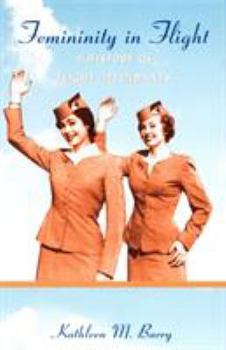Femininity in Flight: A History of Flight Attendants
(Part of the Radical Perspectives Series)
Select Format
Select Condition 
Book Overview
"In her new chic outfit, she looks like anything but a stewardess working. But work she does. Hard, too. And you hardly know it. " So read the text of a 1969 newspaper advertisement for Delta Airlines featuring a picture of a brightly smiling blond stewardess striding confidently down the aisle of an airplane cabin to deliver a meal. From the moment the first stewardesses took flight in 1930, flight attendants became glamorous icons of femininity. For decades, airlines hired only young, attractive, unmarried white women. They marketed passenger service aloft as an essentially feminine exercise in exuding charm, looking fabulous, and providing comfort. The actual work that flight attendants did--ensuring passenger safety, assuaging fears, serving food and drinks, all while conforming to airlines' strict rules about appearance--was supposed to appear effortless; the better that stewardesses performed by airline standards, the more hidden were their skills and labor. Yet today flight attendants are acknowledged safety experts; they have their own unions. Gone are the no-marriage rules, the mandates to retire by thirty-two. In Femininity in Flight , Kathleen M. Barry tells the history of flight attendants, tracing the evolution of their glamorized image as ideal women and their activism as trade unionists and feminists. Barry argues that largely because their glamour obscured their labor, flight attendants unionized in the late 1940s and 1950s to demand recognition and respect as workers and self-styled professionals. In the 1960s and 1970s, flight attendants were one of the first groups to take advantage of new laws prohibiting sex discrimination. Their challenges to airlines' restrictive employment policies and exploitive marketing practices (involving skimpy uniforms and provocative slogans such as "fly me") made them high-profile critics of the cultural mystification and economic devaluing of "women's work." Barry combines attention to the political economy and technology of the airline industry with perceptive readings of popular culture, newspapers, industry publications, and first-person accounts. In so doing, she provides a potent mix of social and cultural history and a major contribution to the history of women's work and working women's activism.
Format:Paperback
Language:English
ISBN:0822339463
ISBN13:9780822339465
Release Date:February 2007
Publisher:Duke University Press
Length:328 Pages
Weight:1.08 lbs.
Dimensions:0.8" x 6.0" x 9.2"
Customer Reviews
1 rating
First-class analysis of an underappreciated position
Published by Thriftbooks.com User , 17 years ago
This gen-x feminist has certainly flown on more than my share of flights thanks to airline deregulation (1978), but having grown up after sex discrimination laws were passed, I also did not previously have the full understanding of all the historical nuances which went into achieving legislative battles making the skies sexism free. It was interesting to read how the stewardess position (as it was then called) became so tightly controlled, ironically having originally developed in an era when there were few other 'interesting' employment opportunities available to women. By the 1950's, the airlines had codes of stewardess conduct which look a million times stricter than anything handed down at my workplaces. Expected to retire at age 35, a woman had to meet certain mandatory height and weight requirements, and could not be married or have any children in order to successfully perform her duties to her customers at all times. Barry's research methodologies expressly delineate though that the airlines, reflective of the larger society's biases, only hired white unmarried girls for these 'jobs' but tellingly did not treat them in the appropriate manner an employer would treat their employees. A stewardess was expected to thanklessly fulfill many tasks simultaneously, mother, sex-pot/kitten, nurse---but in the cruel twist of irony, she also was not welcomed in the union ranks as an equal after undergoing all of these horrific working conditions, the women were expected to continue letting male union leaders represent them as had been the previous tradition. Rather than be docile, that ongoing disparate treatment inadvertently galvanized the women into taking action for each other. Sisterhood wasn't a `trendy slogan' each other was all they had. In the 1970's. a organization called Stewardesses for Women's Rights protested the airline industry's increasingly sexist treatment of women employees and that organization also joined the national campaign for the ratification of the Equal Rights Amendment. I'm certain that airline officials were not intending to create a crop of highly creative and very ticked off feminist activists!





